Global 0.1-Degree Monthly Mean Hourly Total Canopy Solar-Induced Chlorophyll Fluorescence Dataset Derived from Random Forest
Abstract
Highlights
- We have successfully produced a global monthly mean hourly SIF dataset (SIFtotal_01) with a resolution of 0.1° for the years 2000 to 2022.
- SIFtotal_01 bridges a critical gap between ground-based and spaceborne SIF observations, offering valuable insights for research on ecosystem productivity, climate–carbon feedbacks, and vegetation stress.
Abstract
1. Introduction
2. Materials and Methods
2.1. Data
2.1.1. The Diurnal Total Canopy SIF Dataset (SIFtotal)
2.1.2. Diurnal SIF Dataset Produced by Zhao (SIFz)
2.1.3. GPP Dataset
2.1.4. Auxiliary Dataset
2.2. Methods
2.2.1. Model Description
2.2.2. Comparison Between SIF Products and EC Flux GPP
2.2.3. Analysis of the Afternoon Depression of Photosynthesis
3. Results
3.1. Relationship Between SIF and GPP
3.2. SIF-Indicated Afternoon Depression of Photosynthesis
3.3. Drivers of the Diurnal Dynamics of SIF
4. Discussion
4.1. The Relationship Between GPP and SIFtotal_01, SIFtotal and SIFinstant
4.2. Afternoon Depression of Photosynthesis
4.3. Implications of Monthly Mean Hourly SIFtotal_01 and Future Prospects
4.4. Limitations and Applications
5. Conclusions
Author Contributions
Funding
Data Availability Statement
Acknowledgments
Conflicts of Interest
Abbreviations
| APAR | Absorbed photosynthetic active radiation |
| CO2 | Carbon dioxide |
| CV | Coefficient of variation |
| DBF | Deciduous broadleaved forests |
| Depthmax | Max depth of a tree |
| EBF | Evergreen broadleaved forests |
| EC | Eddy covariance |
| ENF | Evergreen Needleleaf forests |
| ERA5 | The fifth generation of European reanalysis |
| EVI | Enhanced vegetation index |
| FPAR | Fraction of absorbed photosynthetic active radiation |
| GPP | Gross primary productivity |
| GRA | Grasslands |
| LAI | Leaf area index |
| MAE | Mean absolute error |
| MHNH | Mid- to high-latitudes of the Northern Hemisphere |
| MODIS | Moderate-resolution imaging spectroradiometer |
| MSE | Mean squared error |
| NDVI | Normalized difference vegetation index |
| NIRv | Near-infrared reflectance of vegetation |
| Ntree | Number of trees |
| OCO | Orbiting the Carbon Observatory |
| OSH | Open shrublands |
| PAR | Photosynthetic active radiation |
| R2 | Goodness of fit |
| RF | Random forest |
| RMSE | Root mean square error |
| RS | Remote sensing |
| SAV | Savannas |
| SD | Standard deviation |
| SIF | Solar-induced chlorophyll fluorescence |
| SIFinstant | Instantaneous SIF |
| SIFnadir | Nadir-viewing SIF |
| SIFtotal_01 | Downscaled monthly mean diurnal SIFtotal product at 0.1° resolution produced in this study |
| SIFtotal | Total canopy SIF emission (dataset) |
| SIFz | SIFinstant dataset produced by Dayang Zhao |
| SM | Soil moisture |
| SMmean | The mean values of the four-layer SM |
| SMn | The SM in the n layer (n = 1, 2, 3, 4) |
| SRdown | Surface solar radiation downward |
| Tair | Air temperature |
| Tdew | Dew point temperature |
| VPD | Vapor pressure deficit |
| WSA | Woody Savannas |
| ΔAPAR | The afternoon–morning APAR difference |
| ΔSIFtotal_01 | The afternoon–morning SIFtotal_01 difference |
| ΔΦSIF | The afternoon–morning ΦSIF difference |
| ΦSIF | SIF yield |
Appendix A
Appendix A.1
| Data Name | Description | Temporal Resolution | Spatial Resolution | Source | Purpose in This Study |
|---|---|---|---|---|---|
| SIFtotal | Total canopy SIF emission retrieval from [14] | Monthly mean hourly, 2000~2022 | 0.5 degree | https://doi.org/10.12199/nesdc.ecodb.rs.2024.029 (accessed on 18 July 2025) | Raw data used for downscaling |
| SIFz | Diurnal SIF dataset produced by [32] | Hourly, only in June–August of 2019~2022 | 0.05 degree | Obtain from co-authors | Compare with our downscaled dataset SIFtotal_01 |
| GPP from FLUXNET2015 | Reference GPP extracted from the half-hourly data of FLUXNET2015 | Half hourly | Site scale | https://fluxnet.org/ (accessed on 31 July 2025) | Compare with our downscaled dataset SIFtotal_01 |
| GPP from Haibei steppe EC flux station | Reference GPP extracted from the half-hourly data of Haibei steppe EC flux station in ChinaFLUX | Half hourly, only in 2019–2020 | Site scale | https://nesdc.org.cn/sdo/detail?id=64e6cd5e7e2817429fbc7afd (accessed on 31 July 2025) | Compare with our downscaled dataset SIFtotal_01 |
| ERA5-Land | The fifth generation of European reanalysis dataset | Hourly | 0.1 degree | https://doi.org/10.24381/cds.e2161bac (accessed on 27 August 2025) | Used for RF modeling, wet or dry year determine, and calculating ΦSIF |
| MODIS MOD13A3 | MODIS vegetation index dataset | 16 day | 1 km | https://doi.org/10.5067/MODIS/MOD13A3.061 (accessed on 18 July 2025) | Used for RF modeling and Site data filter |
| MODIS MCD15A3H | MODIS LAI and FPAR dataset | 4 day | 500 m | https://doi.org/10.5067/MODIS/MCD15A3H.061 (accessed on 18 July 2025) | Used for RF modeling |
| MODIS MCD12Q1 | MODIS land cover dataset | yearly | 500 m | https://doi.org/10.5067/MODIS/MCD12Q1.061 (accessed on 18 July 2025) | Used for land cover classification and site filter |
Appendix A.2
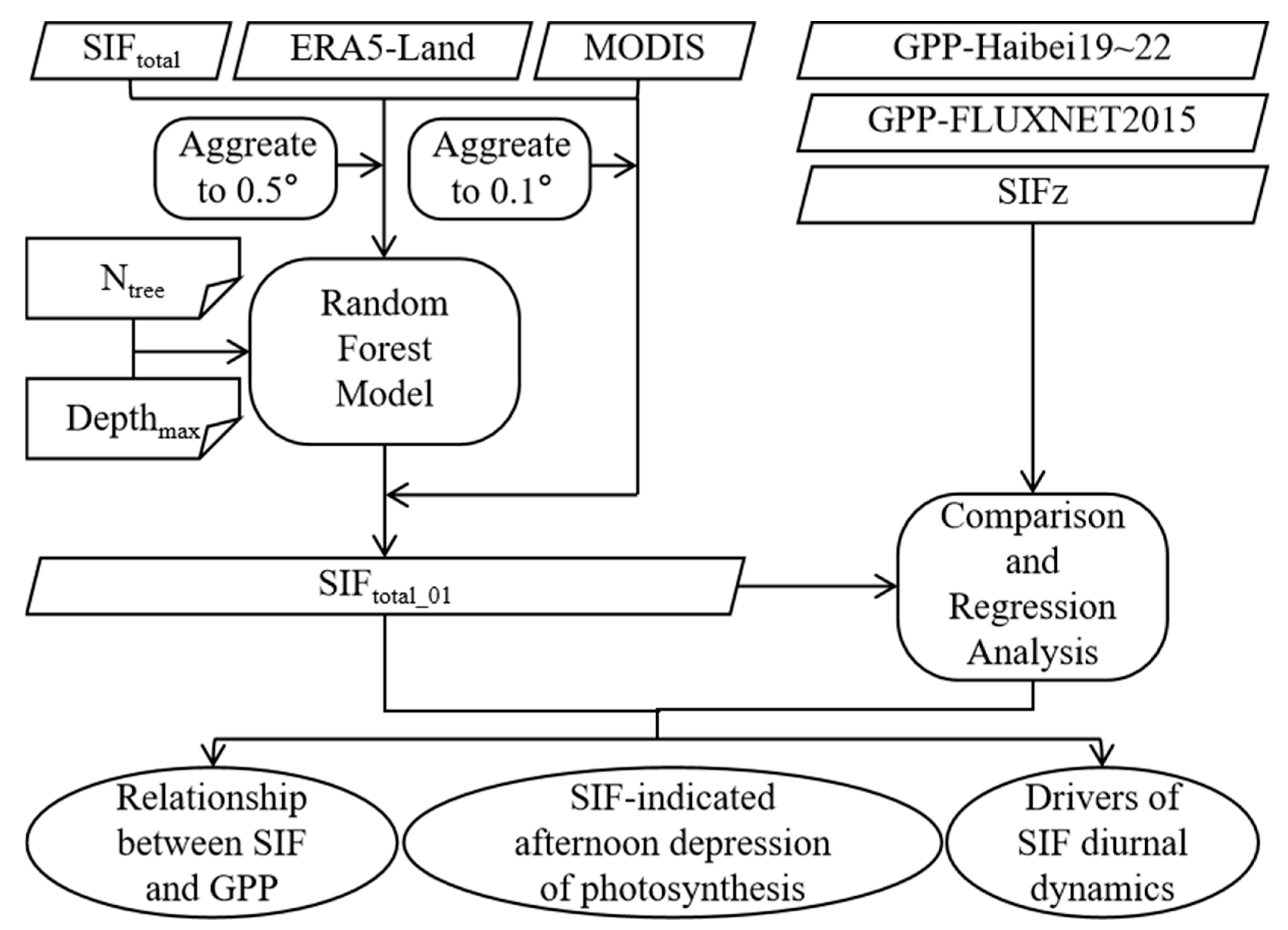
Appendix A.3

References
- Fu, Z.; Stoy, P.; Poulter, B.; Gerken, T.; Zhang, Z.; Wakbulcho, G.; Niu, S. Maximum carbon uptake rate dominates the interannual variability of global net ecosystem exchange. Glob. Change Biol. 2019, 25, 3381–3394. [Google Scholar] [CrossRef]
- Sitch, S.; Friedlingstein, P.; Gruber, N.; Jones, S.; Murray-Tortarolo, G.; Ahlström, A.; Doney, S.; Graven, H.; Heinze, C.; Huntingford, C.; et al. Recent trends and drivers of regional sources and sinks of carbon dioxide. Biogeosciences 2015, 12, 653–679. [Google Scholar] [CrossRef]
- Lin, C.; Gentine, P.; Frankenberg, C.; Zhou, S.; Kennedy, D.; Li, X. Evaluation and mechanism exploration of the diurnal hysteresis of ecosystem fluxes. Agric. For. Meteorol. 2019, 278, 107642. [Google Scholar] [CrossRef]
- Xiao, J.; Fisher, J.; Hashimoto, H.; Ichii, K.; Parazoo, N. Emerging satellite observations for diurnal cycling of ecosystem processes. Nat. Plants 2021, 7, 877–887. [Google Scholar] [CrossRef]
- Lasslop, G.; Reichstein, M.; Papale, D.; Richardson, A.; Arneth, A.; Barr, A.; Stoy, P.; Wohlfahrt, G. Separation of net ecosystem exchange into assimilation and respiration using a light response curve approach: Critical issues and global evaluation. Glob. Change Biol. 2010, 16, 187–208. [Google Scholar] [CrossRef]
- Schimel, D.; Schneider, F.; Bloom, A.; Bowman, K.; Cawse-Nicholson, K.; Elder, C.; Ferraz, A.; Fisher, J.; Hulley, G.; Liu, J.; et al. Flux towers in the sky: Global ecology from space. New Phytol. 2019, 224, 570–584. [Google Scholar] [CrossRef]
- Bodesheim, P.; Jung, M.; Gans, F.; Mahecha, M.; Reichstein, M. Upscaled diurnal cycles of land-atmosphere fluxes: A new global half-hourly data product. Earth Syst. Sci. Data 2018, 10, 1327–1365. [Google Scholar] [CrossRef]
- Nelson, J.; Walther, S.; Gans, F.; Kraft, B.; Weber, U.; Novick, K.; Buchmann, N.; Migliavacca, M.; Wohlfahrt, G.; Sigut, L.; et al. X-BASE: The first terrestrial carbon and water flux products from an extended data-driven scaling framework, FLUXCOM-X. Biogeosciences 2024, 21, 5079–5115. [Google Scholar] [CrossRef]
- Jeong, S.; Ryu, Y.; Dechant, B.; Li, X.; Kong, J.; Choi, W.; Kang, M.; Yeom, J.; Lim, J.; Jang, K.; et al. Tracking diurnal to seasonal variations of gross primary productivity using a geostationary satellite, GK-2A advanced meteorological imager. Remote Sens. Environ. 2023, 284, 113365. [Google Scholar] [CrossRef]
- Khan, A.; Stoy, P.; Joiner, J.; Baldocchi, D.; Verfaillie, J.; Chen, M.; Otkin, J. The Diurnal Dynamics of Gross Primary Productivity Using Observations From the Advanced Baseline Imager on the Geostationary Operational Environmental Satellite-R Series at an Oak Savanna Ecosystem. J. Geophys. Res. Biogeosci. 2022, 127, e2021JG006701. [Google Scholar] [CrossRef]
- Li, X.; Ryu, Y.; Xiao, J.; Dechant, B.; Liu, J.; Li, B.; Jeong, S.; Gentine, P. New-generation geostationary satellite reveals widespread midday depression in dryland photosynthesis during 2020 western US heatwave. Sci. Adv. 2023, 9, eadi0775. [Google Scholar] [CrossRef] [PubMed]
- Yamamoto, Y.; Ichii, K.; Yang, W.; Shikakura, Y.; Ryu, Y.; Kang, M.; Murayama, S.; Kim, S.; Takao, Y.; Ueyama, M.; et al. Modeling diurnal gross primary production in East Asia using Himawari-8/9 geostationary satellite data. Remote Sens. Environ. 2025, 328, 114866. [Google Scholar] [CrossRef]
- Schmit, T.; Griffith, P.; Gunshor, M.; Daniels, J.; Goodman, S.; Lebair, W. A Closer Look at the ABI on the GOES-R Series. Bull. Am. Meteorol. Soc. 2017, 98, 681–698. [Google Scholar] [CrossRef]
- Zhang, Z.; Guanter, L.; Porcar-Castell, A.; Rossini, M.; Labrador, J.; Zhang, Y. Global modeling diurnal gross primary production from OCO-3 solar-induced chlorophyll fluorescence. Remote Sens. Environ. 2023, 285, 113383. [Google Scholar] [CrossRef]
- Guanter, L.; Zhang, Y.; Jung, M.; Joiner, J.; Voigt, M.; Berry, J.; Frankenberg, C.; Huete, A.; Zarco-Tejada, P.; Lee, J.; et al. Global and time-resolved monitoring of crop photosynthesis with chlorophyll fluorescence. Proc. Natl. Acad. Sci. USA 2014, 111, E1327–E1333. [Google Scholar] [CrossRef]
- Porcar-Castell, A.; Malenovsky, Z.; Magney, T.; Van Wittenberghe, S.; Fernández-Marín, B.; Maignan, F.; Zhang, Y.; Maseyk, K.; Atherton, J.; Albert, L.; et al. Chlorophyll a fluorescence illuminates a path connecting plant molecular biology to Earth-system science. Nat. Plants 2021, 7, 998–1009. [Google Scholar] [CrossRef]
- Porcar-Castell, A.; Tyystjärvi, E.; Atherton, J.; van der Tol, C.; Flexas, J.; Pfündel, E.; Moreno, J.; Frankenberg, C.; Berry, J. Linking chlorophyll a fluorescence to photosynthesis for remote sensing applications: Mechanisms and challenges. J. Exp. Bot. 2014, 65, 4065–4095. [Google Scholar] [CrossRef]
- van der Tol, C.; Berry, J.; Campbell, P.; Rascher, U. Models of fluorescence and photosynthesis for interpreting measurements of solar-induced chlorophyll fluorescence. J. Geophys. Res. Biogeosci. 2014, 119, 2312–2327. [Google Scholar] [CrossRef]
- Duveiller, G.; Cescatti, A. Spatially downscaling sun-induced chlorophyll fluorescence leads to an improved temporal correlation with gross primary productivity. Remote Sens. Environ. 2016, 182, 72–89. [Google Scholar] [CrossRef]
- Gentine, P.; Alemohammad, S. Reconstructed Solar-Induced Fluorescence: A Machine Learning Vegetation Product Based on MODIS Surface Reflectance to Reproduce GOME-2 Solar-Induced Fluorescence. Geophys. Res. Lett. 2018, 45, 3136–3146. [Google Scholar] [CrossRef]
- Zhang, Y.; Joiner, J.; Alemohammad, S.; Zhou, S.; Gentine, P. A global spatially contiguous solar-induced fluorescence (CSIF) dataset using neural networks. Biogeosciences 2018, 15, 5779–5800. [Google Scholar] [CrossRef]
- Li, X.; Xiao, J. A Global, 0.05-Degree Product of Solar-Induced Chlorophyll Fluorescence Derived from OCO-2, MODIS, and Reanalysis Data. Remote Sens. 2019, 11, 517. [Google Scholar] [CrossRef]
- Yu, L.; Wen, J.; Chang, C.; Frankenberg, C.; Sun, Y. High-Resolution Global Contiguous SIF of OCO-2. Geophys. Res. Lett. 2019, 46, 1449–1458. [Google Scholar] [CrossRef]
- Wen, J.; Köhler, P.; Duveiller, G.; Parazoo, N.; Magney, T.; Hooker, G.; Yu, L.; Chang, C.; Sun, Y. A framework for harmonizing multiple satellite instruments to generate a long-term global high spatial-resolution solar-induced chlorophyll fluorescence (SIF). Remote Sens. Environ. 2020, 239, 111644. [Google Scholar] [CrossRef]
- Doughty, R.; Köhler, P.; Frankenberg, C.; Magney, T.; Xiao, X.; Qin, Y.; Wu, X.; Moore, B. TROPOMI reveals dry-season increase of solar-induced chlorophyll fluorescence in the Amazon forest. Proc. Natl. Acad. Sci. USA 2019, 116, 22393–22398. [Google Scholar] [CrossRef]
- Sun, Y.; Frankenberg, C.; Wood, J.; Schimel, D.; Jung, M.; Guanter, L.; Drewry, D.; Verma, M.; Porcar-Castell, A.; Griffis, T.; et al. OCO-2 advances photosynthesis observation from space via solar-induced chlorophyll fluorescence. Science 2017, 358, eaam5747. [Google Scholar] [CrossRef]
- Zhang, Y.; Xiao, X.; Zhang, Y.; Wolf, S.; Zhou, S.; Joiner, J.; Guanter, L.; Verma, M.; Sun, Y.; Yang, X.; et al. On the relationship between sub-daily instantaneous and daily total gross primary production: Implications for interpreting satellite-based SIF retrievals. Remote Sens. Environ. 2018, 205, 276–289. [Google Scholar] [CrossRef]
- Doughty, R.; Kurosu, T.; Parazoo, N.; Köhler, P.; Wang, Y.; Sun, Y.; Frankenberg, C. Global GOSAT, OCO-2, and OCO-3 solar-induced chlorophyll fluorescence datasets. Earth Syst. Sci. Data 2022, 14, 1513–1529. [Google Scholar] [CrossRef]
- Stavros, E.; Schimel, D.; Pavlick, R.; Serbin, S.; Swann, A.; Duncanson, L.; Fisher, J.; Fassnacht, F.; Ustin, S.; Dubayah, R.; et al. ISS observations offer insights into plant function. Nat. Ecol. Evol. 2017, 1, 0194. [Google Scholar] [CrossRef]
- Zhang, Y.; Fang, J.; Smith, W.; Wang, X.; Gentine, P.; Scott, R.; Migliavacca, M.; Jeong, S.; Litvak, M.; Zhou, S. Satellite solar-induced chlorophyll fluorescence tracks physiological drought stress development during 2020 southwest US drought. Glob. Change Biol. 2023, 29, 3395–3408. [Google Scholar] [CrossRef]
- Jeong, S.; Ryu, Y.; Li, X.; Dechant, B.; Liu, J.; Kong, J.; Choi, W.; Fang, J.; Lian, X.; Gentine, P. GEOSIF: A continental-scale sub-daily reconstructed solar-induced fluorescence derived from OCO-3 and GK-2A over Eastern Asia and Oceania. Remote Sens. Environ. 2024, 311, 114284. [Google Scholar] [CrossRef]
- Zhao, D.; Zhang, Z.; Zhang, Y. Large-scale diurnal responses of solar-induced chlorophyll fluorescence (SIF) to varying heat and water stresses: Implications for monitoring SIF variations from satellite observations. Remote Sens. Environ. 2025, 324, 114748. [Google Scholar] [CrossRef]
- Zhang, Z.; Zhang, Y. Solar angle matters: Diurnal pattern of solar-induced chlorophyll fluorescence from OCO-3 and TROPOMI. Remote Sens. Environ. 2023, 285, 113380. [Google Scholar] [CrossRef]
- Yang, P.; van der Tol, C. Linking canopy scattering of far-red sun-induced chlorophyll fluorescence with reflectance. Remote Sens. Environ. 2018, 209, 456–467. [Google Scholar] [CrossRef]
- Zeng, Y.; Badgley, G.; Dechant, B.; Ryu, Y.; Chen, M.; Berry, J. A practical approach for estimating the escape ratio of near-infrared solar-induced chlorophyll fluorescence. Remote Sens. Environ. 2019, 232, 111209. [Google Scholar] [CrossRef]
- Pastorello, G.; Trotta, C.; Canfora, E.; Chu, H.; Christianson, D.; Cheah, Y.; Poindexter, C.; Chen, J.; Elbashandy, A.; Humphrey, M.; et al. The FLUXNET2015 dataset and the ONEFlux processing pipeline for eddy covariance data. Sci. Data 2020, 7, 225. [Google Scholar] [CrossRef]
- Chu, H.; Luo, X.; Ouyang, Z.; Chan, W.; Dengel, S.; Biraud, S.; Torn, M.; Metzger, S.; Kumar, J.; Arain, M.; et al. Representativeness of Eddy-Covariance flux footprints for areas surrounding AmeriFlux sites. Agric. For. Meteorol. 2021, 301, 108350. [Google Scholar] [CrossRef]
- Muñoz-Sabater, J.; Dutra, E.; Agustí-Panareda, A.; Albergel, C.; Arduini, G.; Balsamo, G.; Boussetta, S.; Choulga, M.; Harrigan, S.; Hersbach, H.; et al. ERA5-Land: A state-of-the-art global reanalysis dataset for land applications. Earth Syst. Sci. Data 2021, 13, 4349–4383. [Google Scholar] [CrossRef]
- Alduchov, O.A.; Eskridge, R.E. Improved Magnus form approximation of saturation vapor pressure. J. Appl. Meteorol. (1988–2005) 1996, 35, 601–609. [Google Scholar] [CrossRef]
- Didan, K. MODIS/Terra Vegetation Indices Monthly L3 Global 1 km SIN Grid V061 [Data set]; NASA Land Processes Distributed Active Archive Center: Sioux Falls, SD, USA, 2021. [Google Scholar] [CrossRef]
- Badgley, G.; Field, C.; Berry, J. Canopy near-infrared reflectance and terrestrial photosynthesis. Sci. Adv. 2017, 3, e1602244. [Google Scholar] [CrossRef] [PubMed]
- Myneni, R.; Knyazikhin, Y.; Park, T. MODIS/Terra+Aqua Leaf Area Index/FPAR 4-Day L4 Global 500 m SIN Grid V061 [Data set]; NASA Land Processes Distributed Active Archive Center: Sioux Falls, SD, USA, 2021. [Google Scholar] [CrossRef]
- Friedl, M.; Sulla-Menashe, D. MODIS/Terra+Aqua Land Cover Type Yearly L3 Global 500 m SIN Grid V061 [Data set]; NASA Land Processes Distributed Active Archive Center: Sioux Falls, SD, USA, 2022. [Google Scholar] [CrossRef]
- Breiman, L. Random Forests. In Machine Learning; Elsevier: Amsterdam, The Netherlands, 2001; Volume 45, pp. 5–32. [Google Scholar]
- Zhang, Z.; Zhang, Y.; Zhang, Y. Generating high-resolution total canopy SIF emission from TROPOMI data: Algorithm and application. Remote Sens. Environ. 2023, 295, 113699. [Google Scholar] [CrossRef]
- Morozumi, T.; Kato, T.; Kobayashi, H.; Sakai, Y.; Nakashima, N.; Buareal, K.; Nasahara, K.; Akitsu, T.; Murayama, S.; Noda, H.; et al. Contributions of the understory and midstory to total canopy solar-induced chlorophyll fluorescence in a ground-based study in conjunction with seasonal gross primary productivity in a cool-temperate deciduous broadleaf forest. Remote Sens. Environ. 2023, 284, 113340. [Google Scholar] [CrossRef]
- Zhang, Z.; Chen, J.; Guanter, L.; He, L.; Zhang, Y. From Canopy-Leaving to Total Canopy Far-Red Fluorescence Emission for Remote Sensing of Photosynthesis: First Results From TROPOMI. Geophys. Res. Lett. 2019, 46, 12030–12040. [Google Scholar] [CrossRef]
- Zhang, Z.; Zhang, Y.; Zhang, Q.; Chen, J.; Porcar-Castell, A.; Guanter, L.; Wu, Y.; Zhang, X.; Wang, H.; Ding, D.; et al. Assessing bi-directional effects on the diurnal cycle of measured solar-induced chlorophyll fluorescence in crop canopies. Agric. For. Meteorol. 2020, 295, 108147. [Google Scholar] [CrossRef]
- Liu, W.; Luo, S.; Lu, X.; Atherton, J.; Gastellu-Etchegorry, J. Simulation-Based Evaluation of the Estimation Methods of Far-Red Solar-Induced Chlorophyll Fluorescence Escape Probability in Discontinuous Forest Canopies. Remote Sens. 2020, 12, 3962. [Google Scholar] [CrossRef]
- Zhang, Z.; Chen, J.; Zhang, Y.; Li, M. Improving the ability of solar-induced chlorophyll fluorescence to track gross primary production through differentiating sunlit and shaded leaves. Agric. For. Meteorol. 2023, 341, 109658. [Google Scholar] [CrossRef]
- Liu, W.; Atherton, J.; Mottus, M.; Malenovsky, Z.; Luo, S.; Zhang, Y.; Gastellu-Etchegorry, J. Analysing far-red SIF directional anisotropy of three structurally contrasting forest canopies towards improved GPP estimation. Agric. For. Meteorol. 2023, 338, 109531. [Google Scholar] [CrossRef]
- Liu, Y.; Chen, J.; He, L.; Zhang, Z.; Wang, R.; Rogers, C.; Fan, W.; de Oliveira, G.; Xie, X. Non-linearity between gross primary productivity and far-red solar-induced chlorophyll fluorescence emitted from canopies of major biomes. Remote Sens. Environ. 2022, 271, 112896. [Google Scholar] [CrossRef]
- Liu, L.; Zhao, W.; Shen, Q.; Wu, J.; Teng, Y.; Yang, J.; Han, X.; Tian, F. Nonlinear Relationship Between the Yield of Solar-Induced Chlorophyll Fluorescence and Photosynthetic Efficiency in Senescent Crops. Remote Sens. 2020, 12, 1518. [Google Scholar] [CrossRef]
- Zhang, Z.; Zhang, Y.; Porcar-Castell, A.; Joiner, J.; Guanter, L.; Yang, X.; Migliavacca, M.; Ju, W.; Sun, Z.; Chen, S.; et al. Reduction of structural impacts and distinction of photosynthetic pathways in a global estimation of GPP from space-borne solar-induced chlorophyll fluorescence. Remote Sens. Environ. 2020, 240, 111722. [Google Scholar] [CrossRef]
- He, L.; Magney, T.; Dutta, D.; Yin, Y.; Köhler, P.; Grossmann, K.; Stutz, J.; Dold, C.; Hatfield, J.; Guan, K.; et al. From the Ground to Space: Using Solar-Induced Chlorophyll Fluorescence to Estimate Crop Productivity. Geophys. Res. Lett. 2020, 47, e2020GL087474. [Google Scholar] [CrossRef]
- Liu, L.; Guan, L.; Liu, X. Directly estimating diurnal changes in GPP for C3 and C4 crops using far-red sun-induced chlorophyll fluorescence. Agric. For. Meteorol. 2017, 232, 1–9. [Google Scholar] [CrossRef]
- MacBean, N.; Maignan, F.; Bacour, C.; Lewis, P.; Peylin, P.; Guanter, L.; Köhler, P.; Gómez-Dans, J.; Disney, M. Strong constraint on modelled global carbon uptake using solar-induced chlorophyll fluorescence data. Sci. Rep. 2018, 8, 1973. [Google Scholar] [CrossRef] [PubMed]
- Pan, Q.; Cheng, X.; Hu, M.; Liu, L.; Wang, X.; Zhang, J.; Li, Z.; Yuan, W.; Gao, X. The Afternoon/Morning Ratio of Tower-Based Solar-Induced Chlorophyll Fluorescence Can Be Used to Monitor Drought in a Chinese Cork Oak Plantation. Remote Sens. 2024, 16, 1897. [Google Scholar] [CrossRef]
- Lin, J.; Zhou, L.; Wu, J.; Han, X.; Zhao, B.; Chen, M.; Liu, L. Water stress significantly affects the diurnal variation of solar-induced chlorophyll fluorescence (SIF): A case study for winter wheat. Sci. Total Environ. 2024, 908, 168256. [Google Scholar] [CrossRef] [PubMed]
- Liu, Z.; He, X.; Yang, P.; Jiang, H.; Xu, S.; Zhao, H.; Ren, S.; Chen, M. Diurnal Pattern of Sun-Induced Chlorophyll Fluorescence as Reliable Indicators of Crop Water Stress. IEEE Geosci. Remote Sens. Lett. 2023, 20, 1–5. [Google Scholar] [CrossRef]
- Zhu, X.; Hou, Y.; Zhang, Y.; Lu, X.; Liu, Z.; Weng, Q. Potential of Sun-Induced Chlorophyll Fluorescence for Indicating Mangrove Canopy Photosynthesis. J. Geophys. Res. Biogeosci. 2021, 126, e2020JG006159. [Google Scholar] [CrossRef]
- Paul-Limoges, E.; Damm, A.; Hueni, A.; Liebisch, F.; Eugster, W.; Schaepman, M.; Buchmann, N. Effect of environmental conditions on sun-induced fluorescence in a mixed forest and a cropland. Remote Sens. Environ. 2018, 219, 310–323. [Google Scholar] [CrossRef]
- Qiu, R.; Han, G.; Li, X.; Xiao, J.; Liu, J.; Wang, S.; Li, S.; Gong, W. Contrasting responses of relationship between solar-induced fluorescence and gross primary production to drought across aridity gradients. Remote Sens. Environ. 2024, 302, 113984. [Google Scholar] [CrossRef]
- Cheng, X.; Hu, M.; Zhou, Y.; Wang, F.; Liu, L.; Wang, Y.; Huang, H.; Zhang, J. The divergence of micrometeorology sensitivity leads to changes in GPP/SIF between cork oak and poplar. Agric. For. Meteorol. 2022, 326, 109189. [Google Scholar] [CrossRef]
- Cheng, X.; Zhou, Y.; Hu, M.; Wang, F.; Huang, H.; Zhang, J. The Links between Canopy Solar-Induced Chlorophyll Fluorescence and Gross Primary Production Responses to Meteorological Factors in the Growing Season in Deciduous Broadleaf Forest. Remote Sens. 2021, 13, 2363. [Google Scholar] [CrossRef]
- Chen, J.; Wang, S.; Chen, B.; Li, Y.; Amir, M.; Ma, L.; Zhu, K.; Yang, F.; Wang, X.; Liu, Y.; et al. Comparative Analysis on the Estimation of Diurnal Solar-Induced Chlorophyll Fluorescence Dynamics for a Subtropical Evergreen Coniferous Forest. Remote Sens. 2021, 13, 3143. [Google Scholar] [CrossRef]
- Tang, J.; Niu, B.; Fu, G.; Peng, J.; Hu, Z.; Zhang, X. Shifted trend in drought sensitivity of vegetation productivity from 1982 to 2020. Agric. For. Meteorol. 2025, 362, 110388. [Google Scholar] [CrossRef]
- Wang, N.; Suomalainen, J.; Bartholomeus, H.; Kooistra, L.; Masiliunas, D.; Clevers, J. Diurnal variation of sun-induced chlorophyll fluorescence of agricultural crops observed from a point-based spectrometer on a UAV. Int. J. Appl. Earth Obs. Geoinf. 2021, 96, 102276. [Google Scholar] [CrossRef]
- Zhang, Z.; Cescatti, A.; Wang, Y.; Gentine, P.; Xiao, J.; Guanter, L.; Huete, A.; Wu, J.; Chen, J.; Ju, W.; et al. Large diurnal compensatory effects mitigate the response of Amazonian forests to atmospheric warming and drying. Sci. Adv. 2023, 9, eabq4974. [Google Scholar] [CrossRef] [PubMed]
- Xie, X.; Zhao, W.; Yin, G.; Fu, H.; Wang, X. Divergent Ecological Restoration Driven by Afforestation Along the North and South Banks of the Yarlung Zangbo Middle Reach. Land Degrad. Dev. 2025, 36, 521–532. [Google Scholar] [CrossRef]
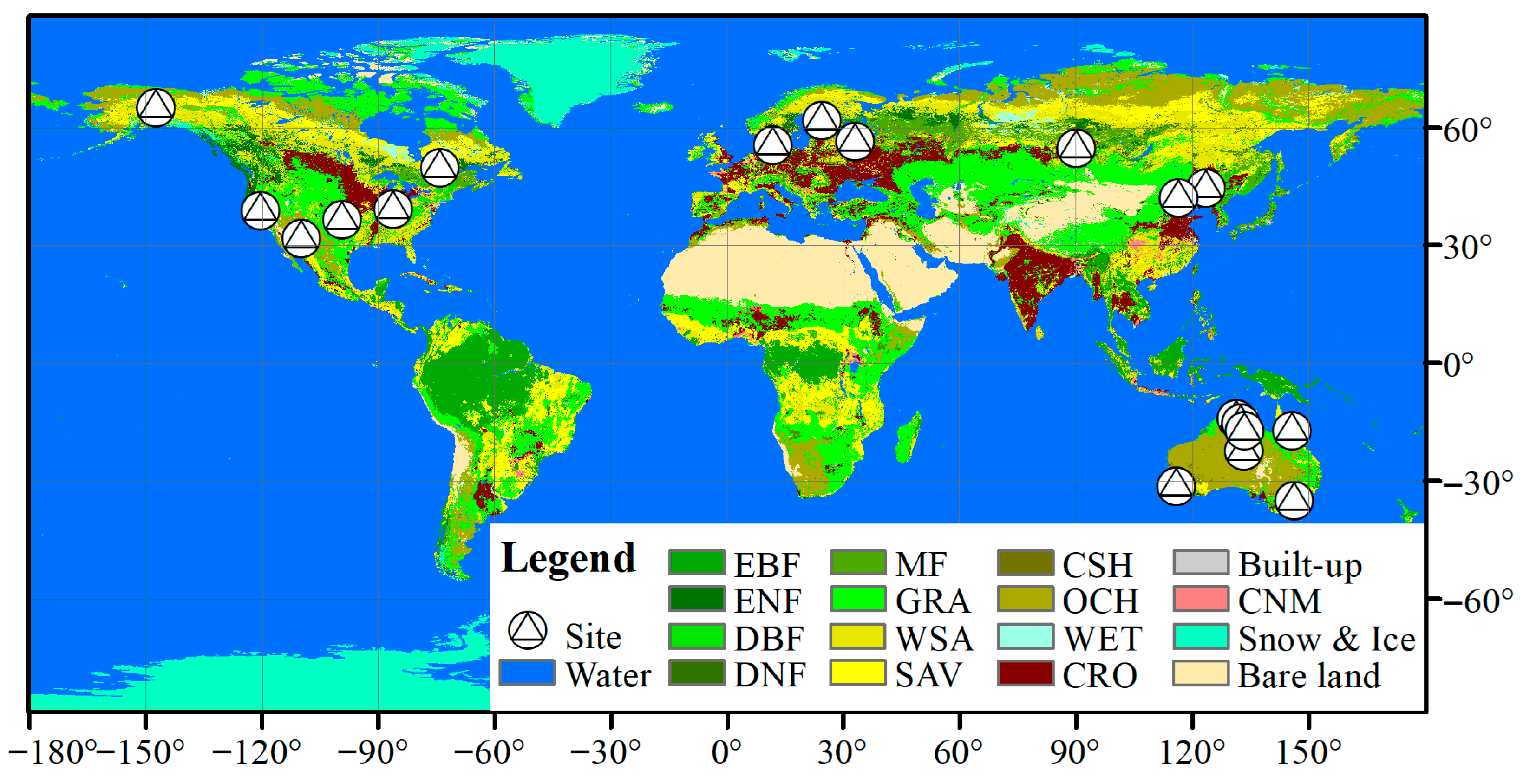
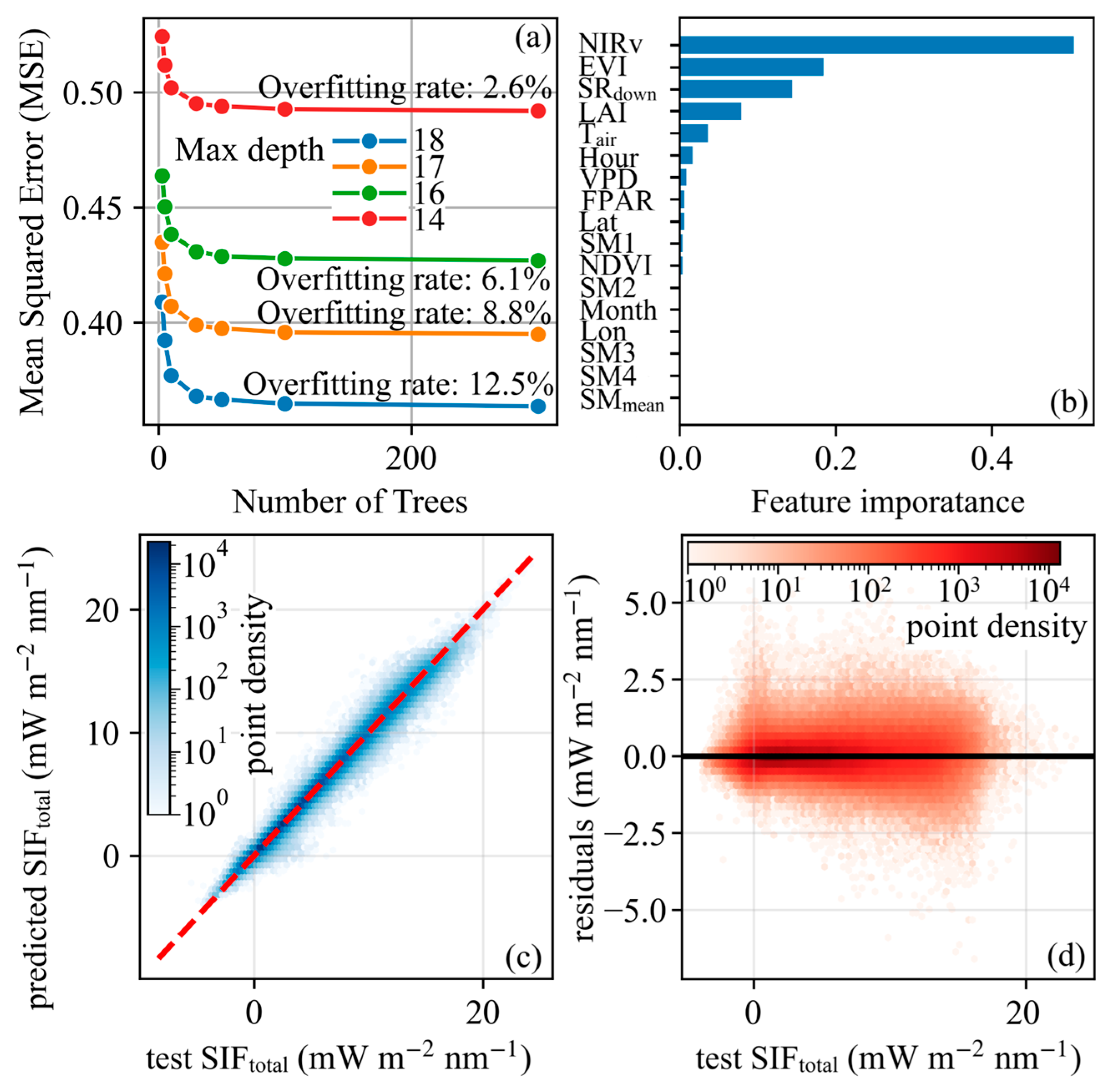
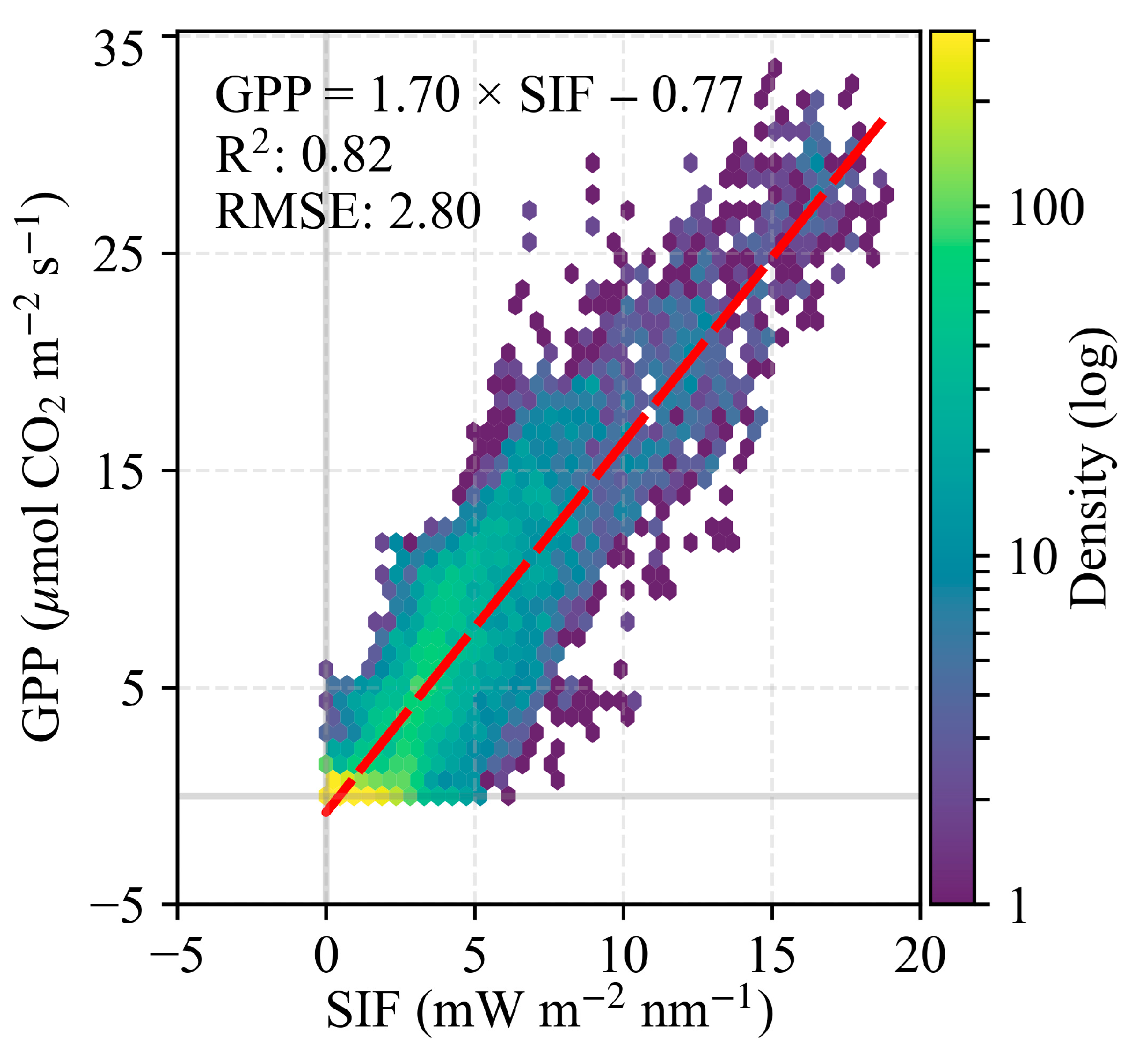
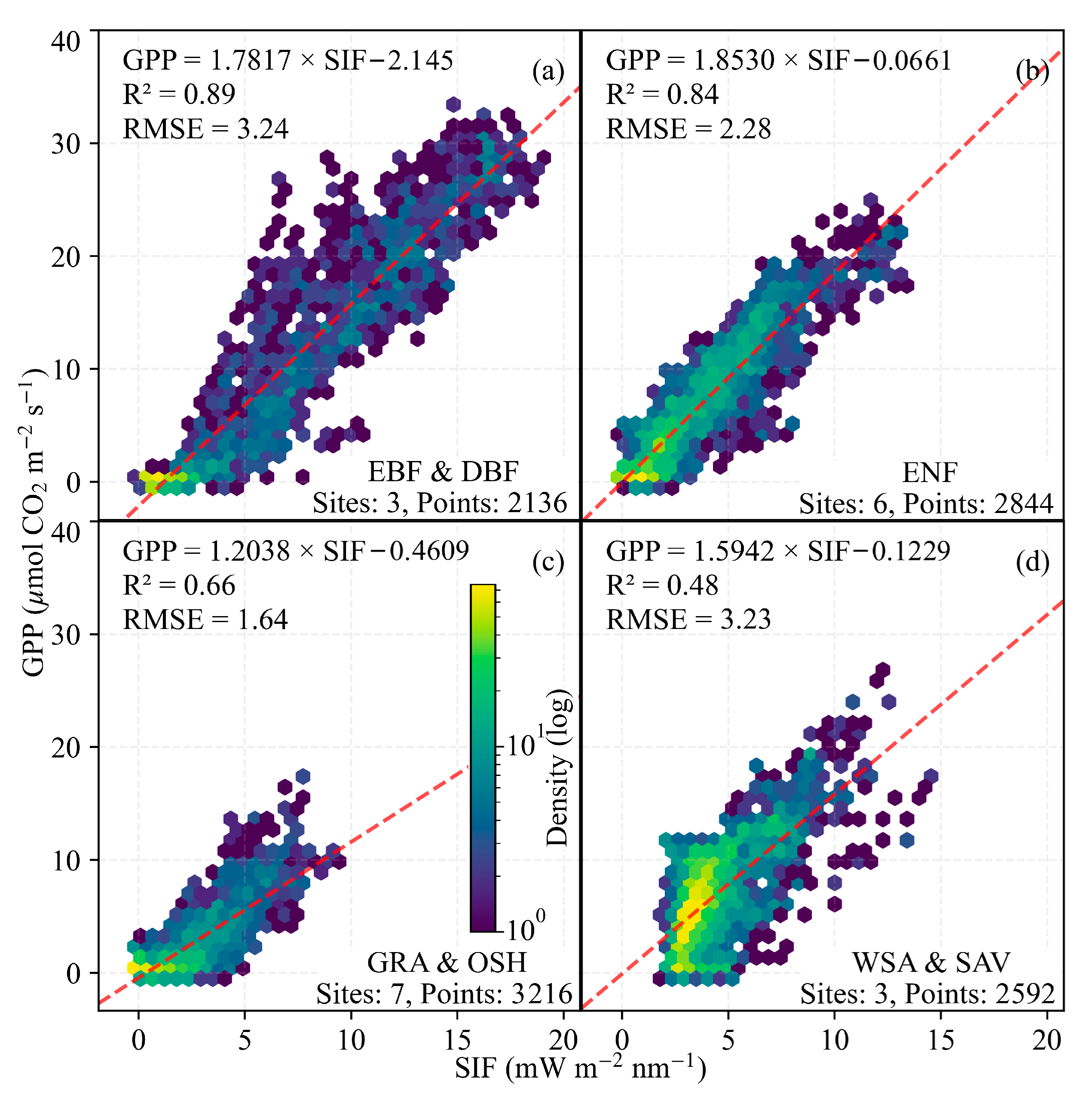

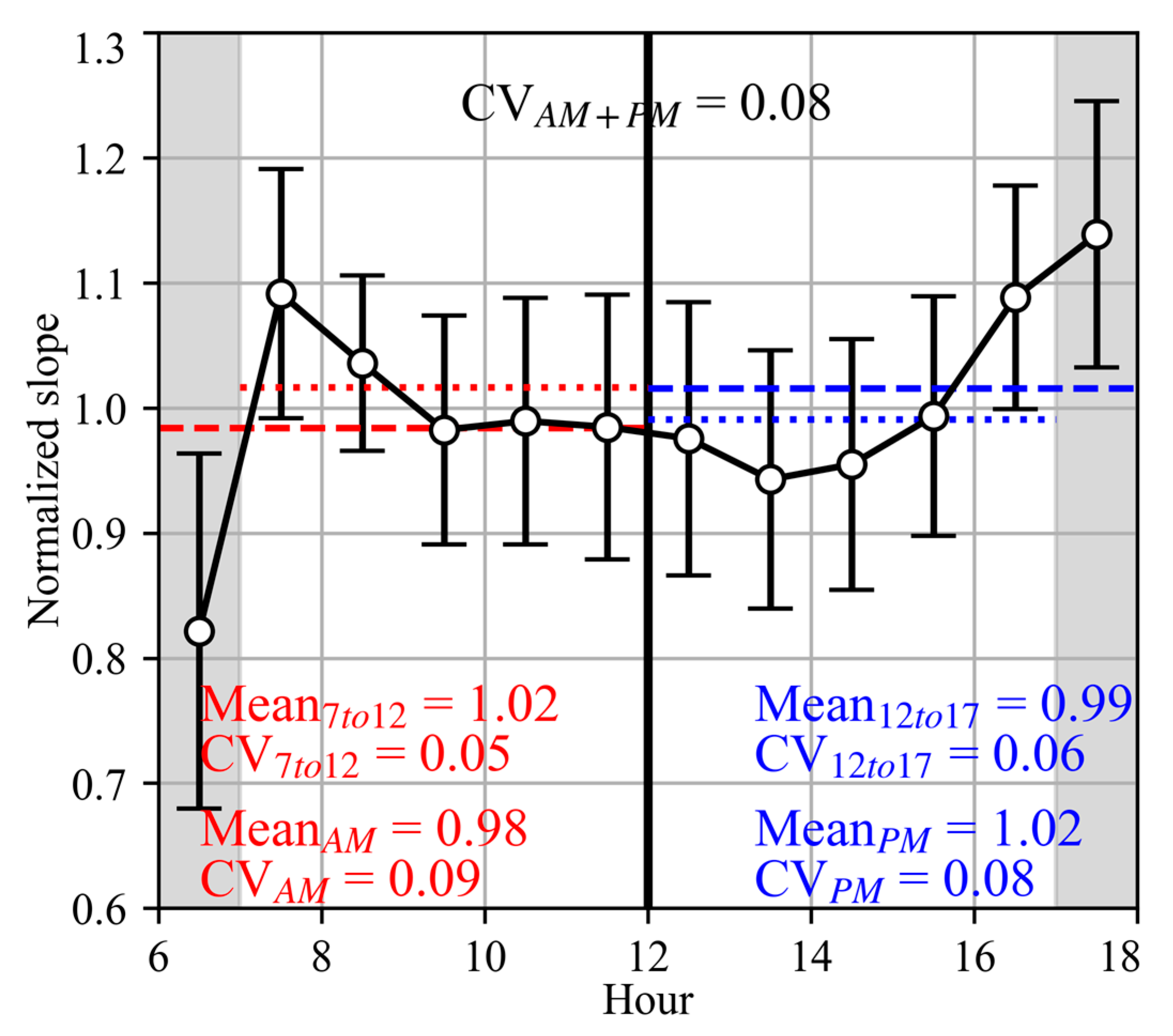


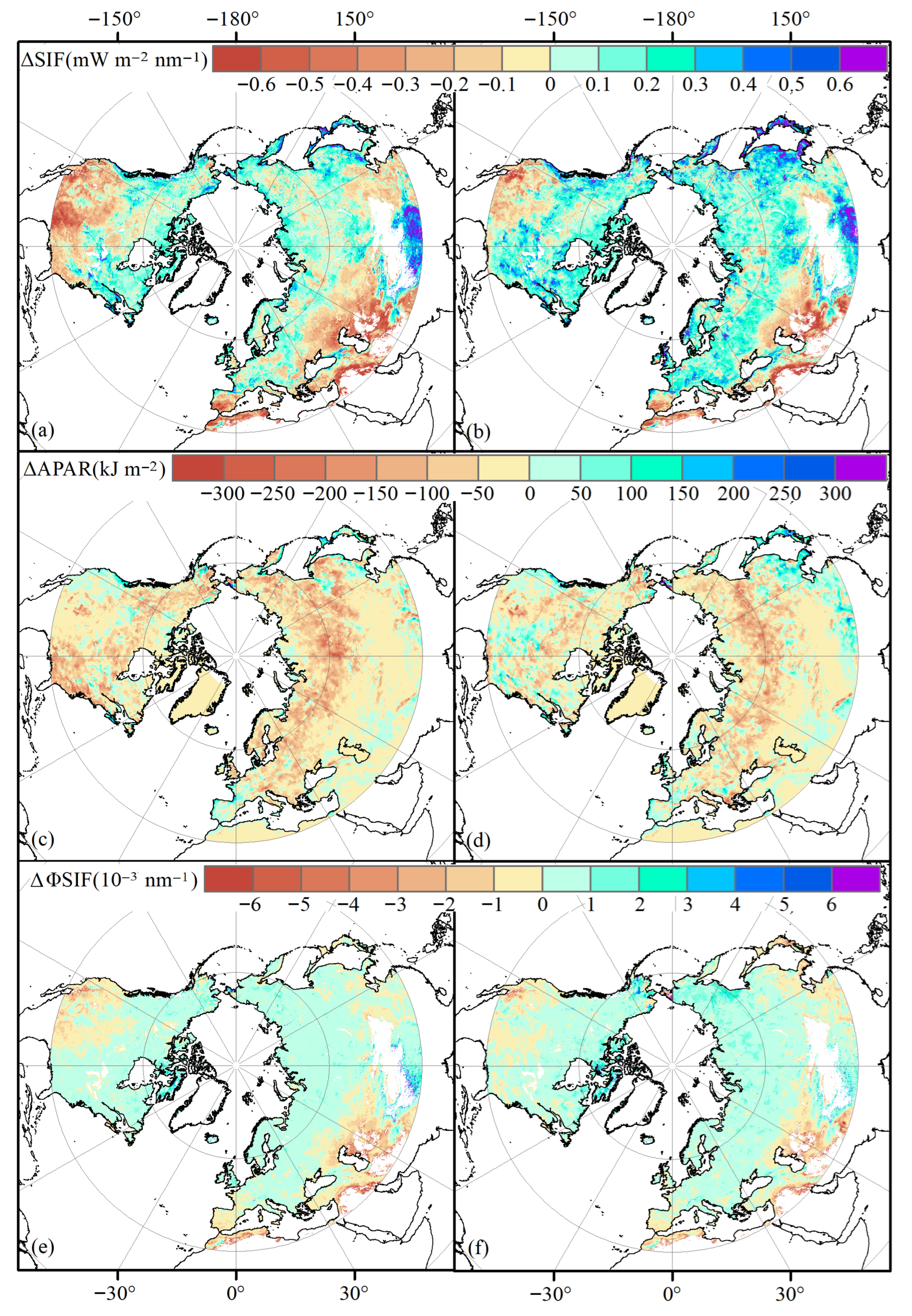
| Comparison | MSE | MAE | RMSE | R2 | Slope | Intercept |
|---|---|---|---|---|---|---|
| GPP v.s. SIFtotal_01 in all IGBP types | 7.81 | 2.11 | 2.8 | 0.82 | 1.7 | −0.77 |
| EBF and DEF | 3.09 | 1.43 | 1.76 | 0.89 | 1.6 | −3.88 |
| ENF | 5.21 | 1.76 | 2.28 | 0.84 | 1.85 | −0.07 |
| GRA and OSH | 2.7 | 1.19 | 1.64 | 0.66 | 1.2 | −0.46 |
| WSA and SAV | 10.46 | 2.58 | 3.23 | 0.48 | 1.59 | −0.12 |
| GPP v.s. SIFtotal in all IGBP types | 8.32 | 2.24 | 2.89 | 0.81 | 1.81 | −0.97 |
| EBF and DEF | 5.39 | 1.96 | 2.32 | 0.8 | 1.42 | −1.53 |
| ENF | 5 | 1.77 | 2.24 | 0.84 | 1.88 | 0.01 |
| GRA and OSH | 3.05 | 1.31 | 1.75 | 0.64 | 1.27 | −0.73 |
| WSA and SAV | 10.84 | 2.65 | 3.29 | 0.46 | 1.58 | 0.28 |
Disclaimer/Publisher’s Note: The statements, opinions and data contained in all publications are solely those of the individual author(s) and contributor(s) and not of MDPI and/or the editor(s). MDPI and/or the editor(s) disclaim responsibility for any injury to people or property resulting from any ideas, methods, instructions or products referred to in the content. |
© 2025 by the authors. Licensee MDPI, Basel, Switzerland. This article is an open access article distributed under the terms and conditions of the Creative Commons Attribution (CC BY) license (https://creativecommons.org/licenses/by/4.0/).
Share and Cite
Liu, Y.; Zhao, D.; Zhang, Y.; Zhang, Z. Global 0.1-Degree Monthly Mean Hourly Total Canopy Solar-Induced Chlorophyll Fluorescence Dataset Derived from Random Forest. Remote Sens. 2025, 17, 3429. https://doi.org/10.3390/rs17203429
Liu Y, Zhao D, Zhang Y, Zhang Z. Global 0.1-Degree Monthly Mean Hourly Total Canopy Solar-Induced Chlorophyll Fluorescence Dataset Derived from Random Forest. Remote Sensing. 2025; 17(20):3429. https://doi.org/10.3390/rs17203429
Chicago/Turabian StyleLiu, Yaojie, Dayang Zhao, Yongguang Zhang, and Zhaoying Zhang. 2025. "Global 0.1-Degree Monthly Mean Hourly Total Canopy Solar-Induced Chlorophyll Fluorescence Dataset Derived from Random Forest" Remote Sensing 17, no. 20: 3429. https://doi.org/10.3390/rs17203429
APA StyleLiu, Y., Zhao, D., Zhang, Y., & Zhang, Z. (2025). Global 0.1-Degree Monthly Mean Hourly Total Canopy Solar-Induced Chlorophyll Fluorescence Dataset Derived from Random Forest. Remote Sensing, 17(20), 3429. https://doi.org/10.3390/rs17203429





